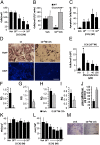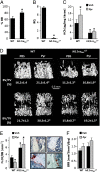Skeletal parasympathetic innervation communicates central IL-1 signals regulating bone mass accrual
- PMID: 22949675
- PMCID: PMC3458367
- DOI: 10.1073/pnas.1206061109
Skeletal parasympathetic innervation communicates central IL-1 signals regulating bone mass accrual
Abstract
Bone mass accrual is a major determinant of skeletal mass, governed by bone remodeling, which consists of bone resorption by osteoclasts and bone formation by osteoblasts. Bone mass accrual is inhibited by sympathetic signaling centrally regulated through activation of receptors for serotonin, leptin, and ACh. However, skeletal activity of the parasympathetic nervous system (PSNS) has not been reported at the bone level. Here we report skeletal immune-positive fibers for the PSNS marker vesicular ACh transporter (VAChT). Pseudorabies virus inoculated into the distal femoral metaphysis is identifiable in the sacral intermediolateral cell column and central autonomic nucleus, demonstrating PSNS femoral innervation originating in the spinal cord. The PSNS neurotransmitter ACh targets nicotinic (nAChRs), but not muscarinic receptors in bone cells, affecting mainly osteoclasts. nAChR agonists up-regulate osteoclast apoptosis and restrain bone resorption. Mice deficient of the α(2)nAChR subunit have increased bone resorption and low bone mass. Silencing of the IL-1 receptor signaling in the central nervous system by brain-specific overexpression of the human IL-1 receptor antagonist (hIL1ra(Ast)(+/+) mice) leads to very low skeletal VAChT expression and ACh levels. These mice also exhibit increased bone resorption and low bone mass. In WT but not in hIL1ra(Ast)(+/+) mice, the cholinergic ACh esterase inhibitor pyridostigmine increases ACh levels and bone mass apparently by inhibiting bone resorption. Taken together, these results identify a previously unexplored key central IL-1-parasympathetic-bone axis that antagonizes the skeletal sympathetic tone, thus potently favoring bone mass accrual.
Conflict of interest statement
The authors declare no conflict of interest.
Figures






References
-
- Rodan GA, Martin TJ. Therapeutic approaches to bone diseases. Science. 2000;289:1508–1514. - PubMed
-
- Elefteriou F, et al. Leptin regulation of bone resorption by the sympathetic nervous system and CART. Nature. 2005;434:514–520. - PubMed
-
- Katayama Y, et al. Signals from the sympathetic nervous system regulate hematopoietic stem cell egress from bone marrow. Cell. 2006;124:407–421. - PubMed
-
- Tam J, et al. The cannabinoid CB1 receptor regulates bone formation by modulating adrenergic signaling. FASEB J. 2008;22:285–294. - PubMed
Publication types
MeSH terms
Substances
LinkOut - more resources
Full Text Sources
Molecular Biology Databases

